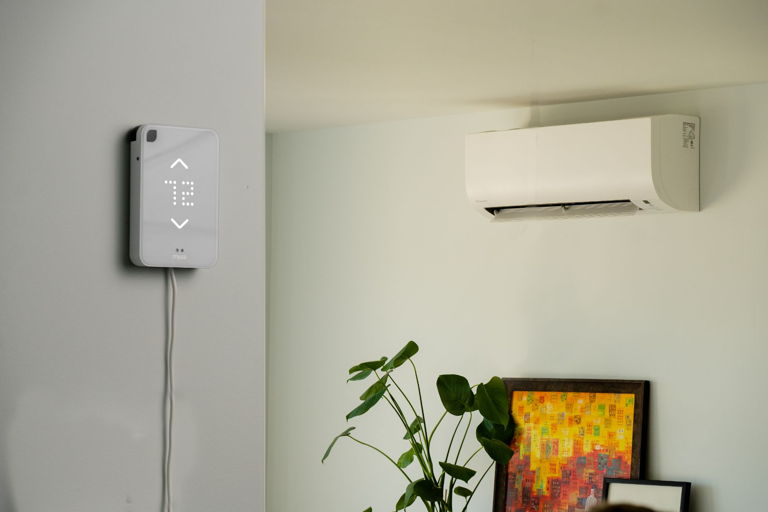To run refrigerant lines through walls, measure and cut a path then secure and insulate the lines. Use proper fittings to connect and protect the tubing.
Running refrigerant lines is a critical step in installing a heating, ventilation, and air conditioning (HVAC) system. Efficiency and performance hinge upon proper installation techniques. Professional HVAC technicians often undertake this complex task to ensure compliance with local building codes and manufacturer specifications.
Installing these lines involves planning the route, avoiding electrical wires and structural components. Careful consideration of the line set’s size and insulation is crucial for optimal system efficiency. The process also typically involves drilling holes, fastening the lines securely to interior wall studs, and making sure joints are sealed and insulated to minimize energy loss. This introduction sets the foundation for a practical guide on how to safely and effectively run refrigerant lines through the walls of a home or building.

Credit: www.amazon.com
Refrigerant Line Basics
Refrigerant lines are the backbone of your cooling system. They carry coolness from an outside unit into your home. Think of them like straws, but for your air conditioner or heat pump. It is crucial to install them right.
Types Of Refrigerant Lines
Refrigerant lines come in two main types:
- Suction lines, which carry cool vapor.
- Liquid lines, which transport liquid refrigerant.
These pipes are usually made of copper or aluminum. They vary in size depending on the system’s requirements.
Importance Of Proper Installation
Installing refrigerant lines properly is key. Correct installation:
- Ensures efficient system operation.
- Prevents coolant leaks.
- Reduces risk of damage to your home.
- Guarantees a longer lifespan for your system.
Always follow local codes and manufacturer’s guidelines. Ensure openings for lines are sealed to keep out pests and moisture.

Credit: ongaroandsons.com
Pre-installation Planning
Pre-Installation Planning ensures a seamless and efficient setup of refrigerant lines within walls. This phase lays the groundwork for a successful installation. By carefully selecting the right path, estimating the required lengths, and gathering essential materials, the process becomes straightforward.
Selecting The Route
A well-chosen path for refrigerant lines minimizes bends and length, boosting system efficiency. Ensure the route avoids electrical wiring, plumbing, and structural components. Easy access for future maintenance is vital. Aim for the shortest, most direct path.
Calculating Line Lengths
Accurate measurements ensure the perfect fit. Use a tape measure to detail the planned route’s length. Add extra for unexpected adjustments. Keep refrigerant flow and pressure drop in mind; long runs may require upsizing.
Materials And Tools Needed
- Copper tubing: Size based on system requirements
- Refrigerant line insulation: For efficiency and condensation prevention
- Pipe cutter: For precise cuts
- Flaring tool: For secure connections
- Sand cloth: To clean pipe ends
- Torque wrench: To ensure proper fittings
- Fire-stop sealant: For wall penetration safety
Gather these tools before starting to ensure a smooth installation.
Wall Preparation
When installing refrigerant lines, preparing the walls is crucial for a smooth process. This preparation ensures the refrigerant lines fit securely without causing damage to the wall structure. Let’s explore the necessary steps to get the walls ready.
Identifying Wall Structure
Knowing what’s inside your walls is the first step. Use a stud finder to locate studs, joists, and any existing electrical wiring or plumbing. Mark these locations with a pencil for easy reference.
Creating Access Points
Once you know where the studs and vital components are, outline the cutting area. Use a drywall saw to create openings for the refrigerant lines. Make sure the size of the access points is just right for the lines to pass through without excessive gaps.
Ensuring Structural Integrity
Never compromise the wall’s strength. If you need to cut near studs, leave a sufficient buffer to maintain stability. When in doubt, consult a structural engineer to avoid potential hazards.
- Use protective grommets where the lines pass through the wall to prevent damage over time from vibration and friction.
- Seal the access points properly to block moisture and pests.
Running The Lines
Air conditioning and refrigeration systems require careful planning. Running the Lines is one such critical step. It involves moving refrigerant lines through walls safely and efficiently. These lines are the veins of your system, carrying the lifeblood of refrigerant. Get it right, and you’ll ensure optimal performance and longevity.
Step-by-step Guide To Threading Lines
Thread refrigerant lines with care to avoid leaks or damage. Here’s how to do it:
- Identify the Route: Plan the shortest and straightest path from the condenser to the evaporator.
- Drill Holes: Use a hole saw to create access points in the wall studs.
- Protect with Sleeves: Insert protective sleeves in the holes to shield the lines from wear.
- Thread Carefully: Gently feed the lines through the holes, avoiding kinks.
Insulating Refrigerant Lines
Proper insulation maintains refrigerant temperature and efficiency. Employ these tips:
- Wrap the Lines: Use insulation foam or tape specially designed for refrigerant lines.
- Cover Completely: Ensure no sections of the line are exposed to prevent energy loss.
- Secure Insulation: Tape or clamp the insulation in place to avoid slipping.
Securing Lines Within Walls
Stable lines mean a quieter, more reliable system. Follow these steps for securing:
- Use Clamps: Attach the lines to studs or joists with approved clamps.
- Space Appropriately: Clamps should be spaced no more than every 4 feet along the line.
- Check for Movement: Ensure the lines do not rub against each other or the walls.
Finishing Touches
Now that the refrigerant lines are in place, let’s apply the finishing touches that ensure system efficiency and integrity. These final steps are crucial to protect against potential damage and maintain an appealing home aesthetic.
Sealing Entry And Exit Points
Properly sealing where refrigerant lines enter and exit the wall is essential. It prevents moisture, insects, and debris from entering your home. Use durable sealants like silicone or expanding foam for a weather-tight seal. Make sure to:
- Clean the area around the holes.
- Apply sealant around both sides.
- Check the seal after it dries.
Pressure Testing For Leaks
It’s vital to pressure test the refrigerant lines for leaks. This ensures your system runs efficiently and safely. Use a nitrogen pressure test and look for stable pressure levels. A drop in pressure could indicate a leak. Steps for testing include:
- Attach a pressure gauge to the system.
- Inject nitrogen into the lines.
- Monitor the pressure for changes.
Aesthetic Considerations
Maintaining your home’s beauty is important. Here’s how you can ensure the refrigerant lines do not disrupt your home’s design:
| Action | Reason |
|---|---|
| Use color-matched paint | Blend the lines with the wall |
| Install a cover or chase | Conceal the lines for a clean look |
| Arrange plants or decor | Distract from visible outdoor lines |

Credit: www.truecable.com
Maintenance And Troubleshooting
Your refrigerant lines work hard to keep your home cool. Like all parts of your HVAC system, they need regular check-ups. With the right maintenance and troubleshooting, you’ll prevent problems and get cool air all season.
Routine Inspection Tips
Keep your system at its best with these easy steps:
- Visual Check: Look for any signs of damage or wear.
- Leak Search: Use soapy water on the pipes to spot leaks.
- Insulation Inspection: Make sure insulation is intact and secure.
- Clean Surroundings: Clear debris from around lines to avoid damage.
Addressing Common Issues
Here’s what to do for typical line problems:
| Issue | Action |
|---|---|
| Small Leaks | Use a leak sealant and monitor closely. |
| Noisy Pipes | Secure loose sections with clamps. |
| Poor Cooling | Check for clogs and clear blockages. |
When To Call A Professional
Sometimes you need an expert. Contact a pro:
- If leaks grow: This means a quick fix won’t work.
- With insulation failure: Professional materials last longer.
- For regular tune-ups: Experts catch problems you might miss.
Frequently Asked Questions Of How To Run Refrigerant Lines Through Walls
Can You Run Refrigerant Lines Inside Walls?
Yes, refrigerant lines can be run inside walls, but they must be properly insulated and secured. It is crucial to follow building codes and manufacturer guidelines to ensure safety and system efficiency.
What Is The Proper Installation Method For Refrigerant Lines?
The proper installation involves using the correct size of lines, insulating them, and securing them with clamps. Always follow the manufacturer’s instructions and local building codes during the process.
How Do You Protect Refrigerant Lines In Walls?
To protect refrigerant lines, use durable insulation, fire-rated protection where necessary, and avoid areas with electrical wiring or plumbing to minimize risks. Regular inspection for leaks or damage is also recommended.
What Are The Code Requirements For Refrigerant Lines?
Code requirements vary by region but generally include specifications on line size, type of insulation, fire safety, and proper securing. Always verify with local building codes to ensure compliance.
Conclusion
Running refrigerant lines through walls is straightforward with the right approach. Remember, precision and safety are paramount. Seal and insulate for efficiency. Tackling this task correctly ensures optimal cooling and system longevity. For more detailed guidance, consult a professional. Keep your cool; let your A/C do its job.

